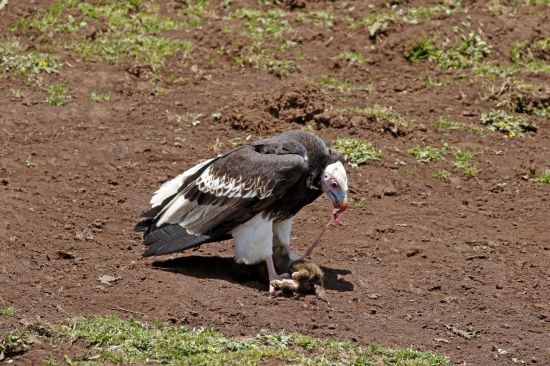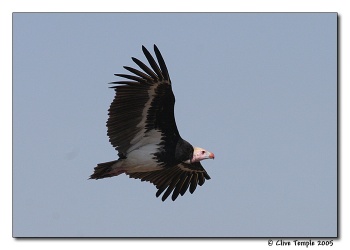Sbarnhardt (talk | contribs) (Add Clearer Image - birdboybowley to species image, moved Gashead image to Identification section) |
|||
| (3 intermediate revisions by 2 users not shown) | |||
| Line 1: | Line 1: | ||
| + | [[File:White-headed_Vulture_BB.jpg|thumb|550px|right|Photo © by {{user|birdboybowley|birdboybowley}}<br />[[Ethiopia]], 13 October 2017]] | ||
;[[:Category:Trigonoceps|Trigonoceps]] occipitalis | ;[[:Category:Trigonoceps|Trigonoceps]] occipitalis | ||
| − | + | ''Aegypius occipitalis'' | |
| − | |||
==Identification== | ==Identification== | ||
| − | White crest | + | [[Image:White-headed_Vulture.jpg|thumb|350px|right|Photo by {{user|Gashead|Gashead}}<br />[[Kruger National Park]], [[South Africa]], May 2005]] |
| + | Length 85 cm, mass 3.3-5.3 kg, females larger than males<br /> | ||
| + | *White crest | ||
| + | *Pale featherless areas on its head | ||
| + | *Dark brown upperparts | ||
| + | *Black tail | ||
| + | *White lower parts and legs | ||
| + | *Pink bill | ||
| + | *Wing span 2 metres. | ||
==Distribution== | ==Distribution== | ||
| − | [[Senegal]] | + | [[Africa]]: breeds across sub-Saharan Africa from [[Senegal]] east to [[Ethiopia]] and north-west [[Somalia]] and south through the eastern half of the continent to the Cape. Uncommon over large parts of range. may still breed in northern [[Mauritania]], the Tibesti of northern [[Chad]] and in south-east [[Egypt]]. |
| + | |||
| + | Now extinct as a wild bird in [[Israel]], where formerly bred in the Negev Desert but may still breed within the [[Western Palearctic]] in northern [[Saudi Arabia]]. | ||
| + | |||
| + | Adults are sedentary but young birds may wander widely. Small numbers are regularly seen in southern Egypt especially between Aswan and Abu Simbel and still occasionally recorded in Israel. Formerly more widespread as a breeding bird in North-West Africa but now largely a vagrant. Also recorded in [[Syria]], [[Jordan]] and in [[Libya]]. | ||
| + | |||
| + | In addition, there is one 19th Century record from [[France]] and possibly also recorded in [[Spain]]. | ||
==Taxonomy== | ==Taxonomy== | ||
| + | This is a [[Dictionary_M-O#M|monotypic]] species<sup>[[#References|[1]]]</sup>. | ||
| + | |||
==Habitat== | ==Habitat== | ||
| − | + | Semi-desert and sparsely wooded grasslands. | |
==Behaviour== | ==Behaviour== | ||
| − | The nest is built in the top of an acacia. | + | It roosts in tall trees near to water at night. |
| − | + | ====Breeding==== | |
| + | The nest is built in the top of an acacia. One egg is laid and incubated by both parents for 55-56 days. The chick will fledge at approximately four months. | ||
| + | ====Diet==== | ||
The diet includes carrion and small mammals. | The diet includes carrion and small mammals. | ||
| + | ==References== | ||
| + | #{{Ref-Clements6thDec10}}#ARKive | ||
| + | {{ref}} | ||
| + | ==External Links== | ||
| + | {{GSearch|Vulture+occipitalis}} | ||
| − | + | [[Category:Birds]] [[Category:Trigonoceps]] | |
| − | |||
| − | |||
| − | [[Category:Birds]] [[Category:Trigonoceps | ||
Latest revision as of 11:39, 4 February 2021
- Trigonoceps occipitalis
Aegypius occipitalis
Identification
Length 85 cm, mass 3.3-5.3 kg, females larger than males
- White crest
- Pale featherless areas on its head
- Dark brown upperparts
- Black tail
- White lower parts and legs
- Pink bill
- Wing span 2 metres.
Distribution
Africa: breeds across sub-Saharan Africa from Senegal east to Ethiopia and north-west Somalia and south through the eastern half of the continent to the Cape. Uncommon over large parts of range. may still breed in northern Mauritania, the Tibesti of northern Chad and in south-east Egypt.
Now extinct as a wild bird in Israel, where formerly bred in the Negev Desert but may still breed within the Western Palearctic in northern Saudi Arabia.
Adults are sedentary but young birds may wander widely. Small numbers are regularly seen in southern Egypt especially between Aswan and Abu Simbel and still occasionally recorded in Israel. Formerly more widespread as a breeding bird in North-West Africa but now largely a vagrant. Also recorded in Syria, Jordan and in Libya.
In addition, there is one 19th Century record from France and possibly also recorded in Spain.
Taxonomy
This is a monotypic species[1].
Habitat
Semi-desert and sparsely wooded grasslands.
Behaviour
It roosts in tall trees near to water at night.
Breeding
The nest is built in the top of an acacia. One egg is laid and incubated by both parents for 55-56 days. The chick will fledge at approximately four months.
Diet
The diet includes carrion and small mammals.
References
- Clements, JF. 2010. The Clements Checklist of Birds of the World. 6th ed., with updates to December 2010. Ithaca: Cornell Univ. Press. ISBN 978-0801445019. Spreadsheet available at http://www.birds.cornell.edu/clementschecklist/Clements%206.5.xls/view
- ARKive
Recommended Citation
- BirdForum Opus contributors. (2024) White-headed Vulture. In: BirdForum, the forum for wild birds and birding. Retrieved 11 May 2024 from https://www.birdforum.net/opus/White-headed_Vulture





